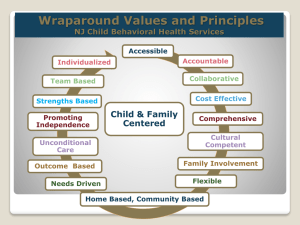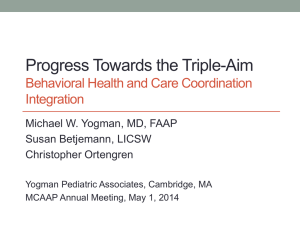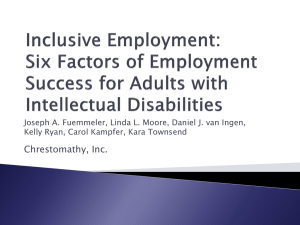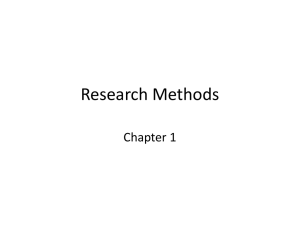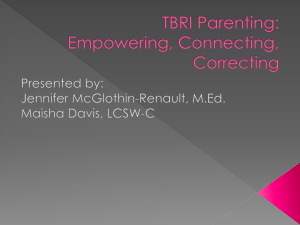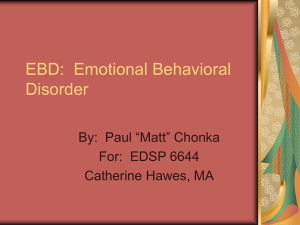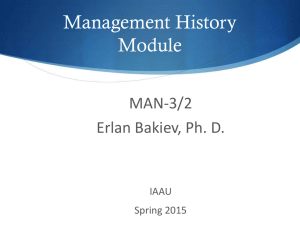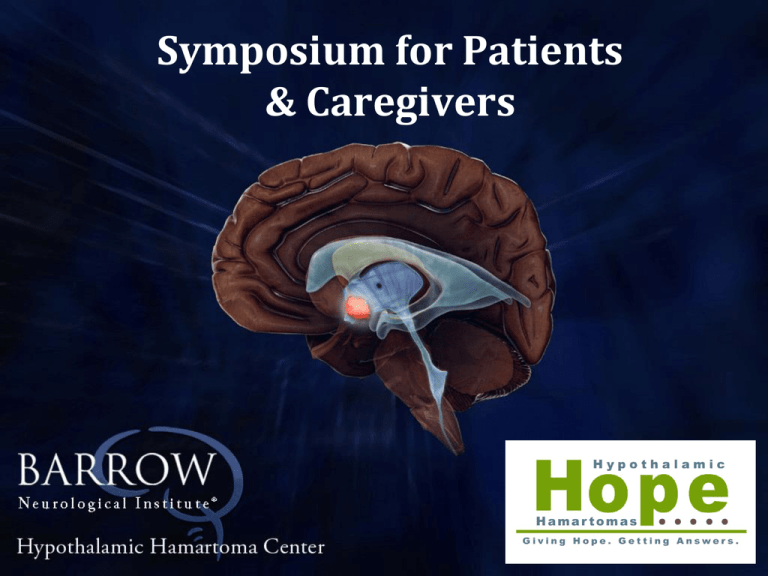
Symposium for Patients
& Caregivers
The Impact of HH on Behavior and Mood:
Rages, Depression, and Socialization
John B. Fulton, Ph.D.
Pediatric Clinical Neuropsychologist
Barrow Neurological Institute, Phoenix Children's Hospital
Outline
• Common emotional and behavioral difficulties with HH
• Psychiatric diagnoses
• Other emotional and behavioral difficulties
• Factors that influence variability
• Treatments
One Size Doesn’t Fit All
What Does the Hypothalamus Have to do
With Behavior?
• The hypothalamus receives input from the limbic
structures, with output including corticotrophin-releasing
hormones
• Ultimately leading to release of cortisol
• The limbic-hypothalamic-pituitary-adrenal (L-HPA) axis
has been tied to psychiatric conditions (e.g. depression and
anxiety)
• The hypothalamus is heavily involved in the sympathetic
nervous system
• “fight or flight” readies the body for action in response to stressor
• Sex hormones have well established behavioral influences
Psychiatric Conditions
• Around 80% of individuals with HH and epilepsy meet
criteria for a psychiatric condition
• Common conditions include:
• Attention Deficit Hyperactivity Disorder (AD/HD)
• Oppositional Defiant / Conduct Disorder
• Pervasive Developmental Disorders
• More common in males?
• Anxiety Disorders
• Obsessive Compulsive Disorder
• Depressive Disorders
• Psychotic Disorders
• Adjustment Disorders
Emotional and Behavioral
Functioning
• Not all behavioral difficulties fit into neat boxes
• Confusion in terms
• Cognitive disorder, NOS v.s. AD/HD
• The same behavior could be representative of differing
diagnoses
• Examples of behaviors without a single label:
• Rage and aggression
• Emotional reactivity outside of mood disorder
• Poor frustration tolerance
• Social impairments that do not fit autism spectrum
• Executive function impairments outside of AD/HD
• Perseverative behavior
Aggression and Rage
Aggression / Rage
• Aggression and rage commonly occur in HH (80%
children in one study)
• Rage Attacks
•
•
•
•
Often more disabling than seizures themselves
Abrupt rage, hitting, biting, kicking, etc.
Sometimes without an identifiable trigger
Can be followed by lack of awareness of event or
immediate remorse
• Rage attacks v.s. “typical” aggression
• Rage attacks v.s. emotional reactivity
Aggression / Rage
• Types of Physical Aggression
• Affective Aggression:
• Non-profitable damaging own property
• Out of Control
• Explosive
• Seemingly without purpose
• Predatory
• Controls own behavior, while aggressive
• Obtains something from aggression
• Fights with weaker children
• In HH more likely to be affective aggression
• Sympathetic nervous system plays a greater role in this form
AD/HD
• Grouped into 3 subtypes:
• Predominantly hyperactive
• Predominantly inattentive
• Combined
• Extensive literature on “developmental” AD/HD
• Primary seen as a disorder of executive
functioning:
• Sustained attention (vigilance)
• Response inhibition (impulse control)
• Behavioral activity
Autism Spectrum Disorders
• 3 main groups of symptoms
• Impairments in social functioning
• Impairments in language and communication
• Stereotyped behaviors OR circumscribed interests
• Autism Spectrum Disorders
• Autism
• Asperger’s Disorder
• Pervasive Developmental Disorder, Not Otherwise
Specified
Adjustment Disorders
• Emotional or behavioral symptoms in response to
a stressor
• Subdivided into
•
•
•
•
•
•
Depressed mood
Anxiety
Anxiety and depressed mood
Disturbance of conduct
Mixed
Unspecified
So Why The Variability?
Neurological
• Localization and size of HH
• Seizure History?
• Seizure types
• Frequency
• Refractory to treatment
• Precocious puberty?
• Age
• Considered a progressive condition
Social Adjustment
(e.g. self perception, perception of others)
Social Interactions
(e.g. overbearing, withdrawn, affiliative, etc.)
Social Information Processing
( e.g. attention, executive skills, memory, etc.)
Adapted from Yeates et al., 2007
Family, Environmental, Factors
Neurological Factors
How Does Cognition Impact Social
Functioning?
Medication Effects
• Variable outcomes for antiepileptic medication
side effects
• In some cases, increased agitation and irritability
• Other AED’s can be used for mood stabilization
• Monitor behavior in response to medications
• Double edged sword given the impact of
uncontrolled epilepsy on cognitive and behavioral
outcomes
The Impact of School Functioning
• Model of Learned Helplessness
• Limited control to improve or reduce a stressor leads to
depression and hopelessness
• Chronic academic deficits may lead to beliefs that
are:
• Permanent “I will never do well in school”
• Personal “I failed the test because I’m dumb”
• Pervasive “Everything I do stinks”
Treatments
The Effects of Surgery
• Multiple studies indicate a positive impact on behavior in
the majority of cases
•
•
•
•
Surgical resection
Vagal nerve stimulation
Gamma knife
Interstitial stereotactic radiosurgery (I-seeds)
• Subjective (e.g. physician or family impression)
• Greatest improvement for patients with more substantial
pre-surgical behavioral impairments
• Behavioral improvements seen in a small group of patients
without epilepsy
The Effects of Surgery
• More studies are needed
• Degree of behavioral improvement?
• Which behaviors have greatest improvement?
• Relationship between seizure improvement and behavioral
outcomes?
• Need for objective assessment of behavior
• Schulze-Bohnage et al. 2004
• 8 cases (4 children, 4 adults) with I-seeds placement
• Improvements on a quality of life measure (adults)
• Child Behavioral Checklist
• 1 child improvements in aggression, attention, and depression
• 1 child improved compulsive behavior, but not aggression,
attention, depression
• 2 children no change
Psychopharmacology Treatments
• ADHD
• Stimulant medications (Ritalin)
• Non-stimulant treatments (Strattera)
• Mood stabilizing medications
• Lithium
• Some antiepileptic meds
• Depression and Anxiety
• SSRI’s (e.g. Prozac and Zoloft)
• Benzodiazepines (anxiety)
• Collaboration is key
Psychotherapy Treatments
• Individual and family psychotherapy
• Considerations include:
• Age
• Developmental level
• Family support
• Nature of the problem
Behavioral Treatments
• Anger management
• Behavioral analysis
• Is the rage/aggression volitional
• Antecedents >> Behavior >> Outcomes
• Patient recognition
• Identification of triggers
• Labeling of physiological markers
• Development of strategies for management
• Reinforcement for using strategies
• Response cost for inappropriate behaviors
• The Explosive Child by Ross Greene
Behavioral Treatments
• AD/HD
• Behavior management of hyperactivity and impulsivity
at home and school
• Reinforcement for on task behavior
• Response cost for inattentive, impulsive, or
overactive behavior
• Scheduling for optimal attention span
• “Cognitive sprinter”
• Taking Charge of AD/HD: The Complete Authoritative
Guide for Parents by Russell Barkley
Behavioral Treatments
• Anxiety and Depression
• Cognitive behavioral therapy (School age children and
older)
• Behavioral activation (depression)
• Systematic desensitization (anxiety)
• Stress management techniques
• Progressive muscle relaxation
• Recognition and alteration of maladaptive thought
processes
• Example “Mindreading”
Behavioral Treatments
• Social Impairments
• Social skills groups
• Friendship Training
• Group interactions
• Homework-supervised play dates
• Social skills training
• Navigating the Social World by Jeanette McAfee
• Individual therapy
Behavioral Treatments
• Autism
• Applied Behavioral Analysis (ABA)
• Provided in home and school
• Intensive works best (20+ hours per week)
• Earlier intervention is better
• Treatment and Education of Autistic and Related
Communication Handicapped Children (TEACCH)
• Also rooted in behavioral intervention
• Focuses on underlying deficits that contribute to
behavior
Wrap Up
• Emotional and behavioral outcomes from HH are variable,
but often substantial
• High rates of psychiatric illness, as well as behaviors not
well defined by existing diagnoses
• Neurological and environmental factors affect outcomes
• Many treatments options for behaviors exist, but further
research is needed to evaluate their efficacy
A Special Thanks to our Sponsors
• Aesculap
• Barrow Neurological Institute @ St. Joseph’s Hospital
• Barrow Neurological Institute @ Phoenix Children’s Hospital
• Great Council for the Improved
• Hope for Hypothalamic Hamartoma Foundation
• KARL STORZ Endoskope

